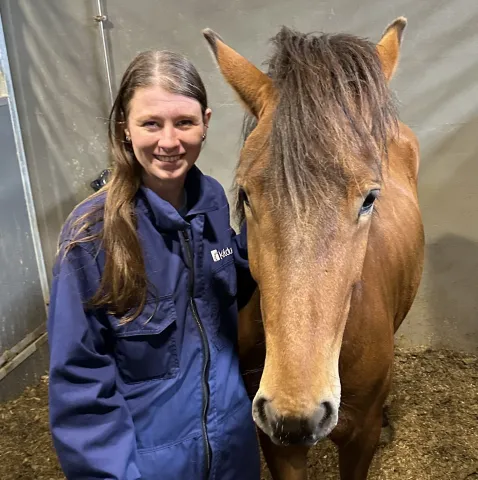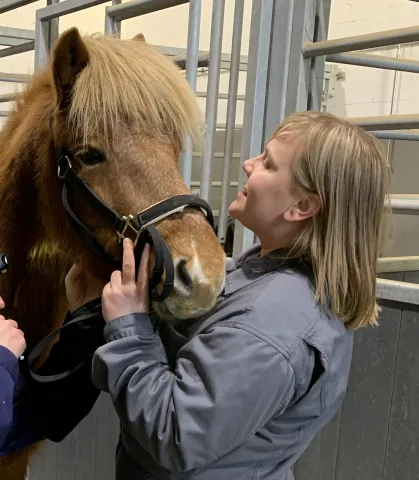06/21/2024
Masters defense
Hafdís María Pétursdóttir defended her M.Sc. thesis June 21st from the medical department, University of Iceland, title: Analysis of cytokine response following vaccination against equine insect bite hypersensitivity. The project was performed at Keldur. Supervisors were dr. Sigríður Jónsdóttir and dr. Vilhjálmur Svansson. Also, in the masters committee was dr. Siggeir Fannar Brynjólfsson. Examiner was dr. Jóna Freysdóttir.
Abstract
The specific aim of this project was to optimize the production and purification of a major allergen (Cul o 5) for use in vaccinations and to establish an effective method to evaluate the cytokine response post-vaccination. Production of Cul o 5 in E. coli in Cinnabar medium and removal of lipopolysaccharide was unsuccessful. Using 2xYT medium, increased protein yield was obtained by altering the production. The purified protein was shown to be stable after lowering the imidazole to 50 mM. PBMCs of allergen boosted horses were re-stimulated in vitro for cytokine measurements by qPCR and bead-based multiplex assay. Primers, probes and parameters of the qPCR were optimized. Due to great difference between the horses, this approach was not tried further. Stimulation of 800,000 cells for 96 hours initially suggested the best condition using the bead-based assay. Subsequent tests on fourteen horses indicated that stimulating for 48 hours is more suitable, as it consistently showed significant differences in cytokine levels before and after boost. The production of problematic major allergens can be improved by altering the production condition. For analyzing the cytokine response following vaccination, the 48- and 96-hours stimulation of 800,000 cells will be repeated in the next IBH vaccination experiments to confirm the optimal time point.
Thesis link: https://hdl.handle.net/1946/48304
07/03/2024
Doctoral defense
Sara Björk Stefánsdóttir defended her doctoral thesis from the medical department, University of Iceland March 7th 2024, title: Development of Immunotherapy for Equine Insect Bite Hypersensitivity. The project was perfomed at Keldur and the Vetsuisse Faculty of University of Bern, Switzerland. Opponents were dr. Hans Grönlund, docent at Karolinska Institutet, Department of Clinical Neuroscience, Sweden and dr. Zophonías Oddur Jónsson, professor at Faculty of Life and Environmental sciences, University of Iceland.
Supervisors were dr. Sigurbjörg Þorsteinsdóttir, immunologist and dr. Vilhjálmur Svansson veterinarian/virologist. Also in the doctoral comittee were dr. Arna Rúnarsdóttir biochemist, dr. Eliane Marti veterinarian/immunologist and dr. Jón Már Björnsson molecular biologist.
Abstract
The major allergens of IBH have been identified and produced which opens the possibility to develop an allergen-specific immunotherapy against IBH. Prior studies showed that intralymphatic (i.l) injection of recombinant (r-) allergens with adjuvants induced a preferable immune response. In this study, two vaccination experiments were carried out, that is comparison of injection route and comparison of adjuvants. Vaccination with r-allergens in alum/MPLA adjuvant i.l. and s.c. gave comparable results. In conclusion, s.c. injection might be option in immunotherapy against IBH. Use of alum/VLP adjuvant instead of alum/MPLA as an immunomodulator induced weaker immune response.
To test the efficacy of a preventive allergen immunotherapy, a challenge experiment was conducted. Twenty - seven healthy Icelandic horses were vaccinated i.l. with r-allergens in alum/MPLA. The vaccination was done in Iceland and the horses subsequently exported to Switzerland and followed for three years with regular clinical examination, blood sampling and booster vaccinations. One horse was withdrawn from the study. Six horses developed IBH (23.1%) in the first year. In the second year a total of 13 horses (50.0%) and in the third year 16 (61.5%) horses were affected with IBH. The IgG antibody response showed no difference at any time-point between horses which developed IBH and horses that remained healthy. However, at the end of the second Culicoides season IBH-affected horses had significantly higher IgE levels. In conclusion, the vaccine did not reduce the incident of IBH in exported horses based on reported prevalence. Further analysis of collected samples could provide insights on why the vaccine does not protect the horses against IBH.
Thesis link: https://opinvisindi.is/handle/20.500.11815/4751

